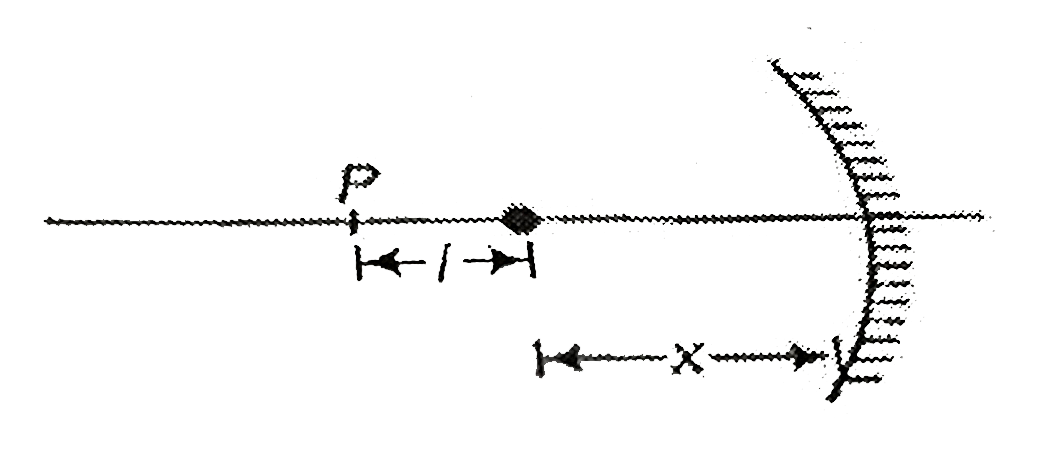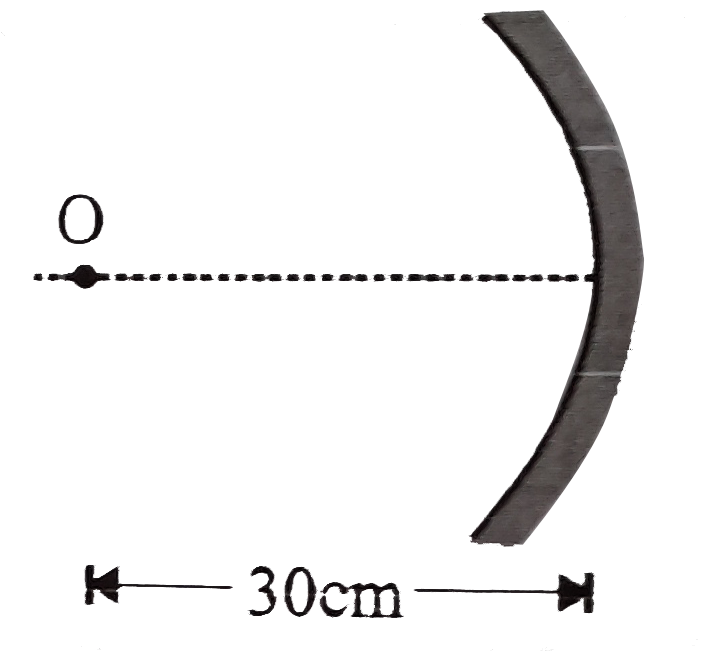A short object of length L is placed along the principal axis of a concave mirror aeay from focus. The object distance is u. If the mirror has a focal length f, what will be the length of the image ? You may take L<<|v−f|.
To solve the problem of finding the length of the image formed by a concave mirror for a short object of length L placed along the principal axis, we can follow these steps:
Step 1: Understanding the Setup
We have a concave mirror with a focal length f. The object is placed at a distance u from the mirror, and the length of the object is L. We need to find the length of the image formed by this mirror.
Step 2: Define Object Points
Since the object has a length L, we can define two points on the object:
- The first point U1 is at a distance u−L2 from the mirror (the left end of the object).
- The second point U2 is at a distance u+L2 from the mirror (the right end of the object).
Step 3: Use the Mirror Formula
The mirror formula is given by:
1f=1v+1u
We can rearrange this to find the image distance v:
v=fuu−f
Step 4: Calculate Image Distances for Both Points
Now we will calculate the image distances V1 and V2 for the two points U1 and U2.
1. For U1:
v1=f(u−L2)u−L2−f
2. For U2:
v2=f(u+L2)u+L2−f
Step 5: Find Length of the Image
The length of the image L′ is given by the difference in the image distances:
L′=|v1−v2|
Step 6: Substitute and Simplify
Substituting the expressions for v1 and v2:
L′=∣∣
∣
∣∣f(u−L2)u−L2−f−f(u+L2)u+L2−f∣∣
∣
∣∣
Step 7: Approximate for Small L
Given that L is much smaller than |u−f|, we can neglect higher-order terms. This leads us to:
L′≈f2L(u−f)2
Final Result
Thus, the length of the image formed by the concave mirror is:
L′=f2L(u−f)2
We have a concave mirror with a focal length f. The object is placed at a distance u from the mirror, and the length of the object is L. We need to find the length of the image formed by this mirror.
Since the object has a length L, we can define two points on the object:
- The first point U1 is at a distance u−L2 from the mirror (the left end of the object).
- The second point U2 is at a distance u+L2 from the mirror (the right end of the object).
The mirror formula is given by:
1f=1v+1u
We can rearrange this to find the image distance v:
v=fuu−f
Now we will calculate the image distances V1 and V2 for the two points U1 and U2.
v1=f(u−L2)u−L2−f
v2=f(u+L2)u+L2−f
The length of the image L′ is given by the difference in the image distances:
L′=|v1−v2|
Substituting the expressions for v1 and v2:
L′=∣∣
∣
∣∣f(u−L2)u−L2−f−f(u+L2)u+L2−f∣∣
∣
∣∣
Given that L is much smaller than |u−f|, we can neglect higher-order terms. This leads us to:
L′≈f2L(u−f)2
Thus, the length of the image formed by the concave mirror is:
L′=f2L(u−f)2
Topper's Solved these Questions
- RAY OPTICSBOOK - PRADEEPCHAPTER - RAY OPTICSEXERCISE - Long Answer (b)
15 Videos
- RAY OPTICSBOOK - PRADEEPCHAPTER - RAY OPTICSEXERCISE - Long Answer (c)
8 Videos
- RAY OPTICSBOOK - PRADEEPCHAPTER - RAY OPTICSEXERCISE - Short Answer(d)
17 Videos
- PROPERTIES OF BULK MATTERBOOK - PRADEEPCHAPTER - PROPERTIES OF BULK MATTEREXERCISE - Multiple choice questions
7 Videos
- SYSTEMS OF PARTICLES AND ROTATIONAL MOTIONBOOK - PRADEEPCHAPTER - SYSTEMS OF PARTICLES AND ROTATIONAL MOTIONEXERCISE - Assertion- Reason Type questions
20 Videos
Similar Questions
A short linear object of length l lies on the axis of a spherical mirror of focal length f, at a distance x from the mirror. Then, the length of the image (P) so obtained will be

View SolutionA short linear object of length b lies on the axis of a concave mirror of focal length F at a distance u from the pole. The length of the image will be
View Solution
Knowledge Check
An object of length 6 cm is placed on the principle axis of a concave mirror of focal length f at a distance of 4 f . The length of the image will be
A2 cmB12 cmC4 cmD1.2 cmA short linear object of length / lies along the axis of a concave mirror of focal length f at a distance d from the pole of the mirror. The approximate size of the image is
AIf(d+f)Bd+ffICIf2(d+f)2DI(d+f)2f2An object is placed on the principal axis of a concave mirror at a distance of 1.5 f(f is the focal length). The image will be at,
A1.5fB−1.5fC3fD−3f
A short linear object of length b lies along the axis of a concave mirror or focal length f at a distance u from the pole of the mirror. The size of the image is approximately equal to
View SolutionA short linear object of length b lies along the axis of a concave mirror or focal length f at a distance u from the pole of the mirror. The size of the image is approximately equal to
View SolutionA short linear object of length / lies along normal to the axis of a concave mirror of focal length f at a distance d from the pole of the mirror. The size of the image is then (nearly)

View SolutionAn object is present on the principal axis of a concave mirror at a distance 30cmfrom it.Focal length of mirror is20cm

Image formed by mirror is
View SolutionA very small object of length a is kept along the axis of a concave mirror of focal length y at a distance x from its pole. Approximate size of the image is
View Solution